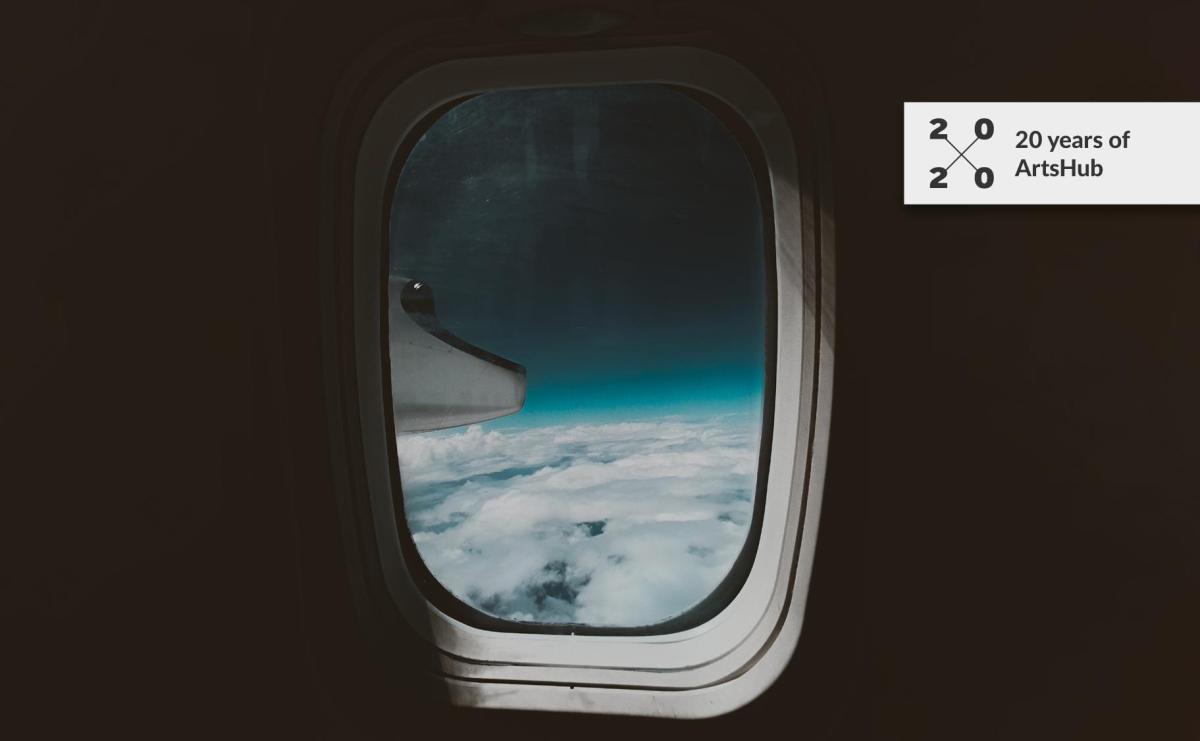Taking your career abroad is currently a two-fold problem: one being our borders are closed; and two, that the cost and challenges don’t always outweigh the outcomes. To coincide with International Artist Day, we take a look back at this article published in January 2015, where writer Naima Morelli posits that, ‘Australians no longer need to look overseas to build an arts career, despite remaining a temptation.’
Perhaps they are lessons helpful in finding motivation in lockdown. This article joins our 20×20 series, celebrating 20 years of ArtsHub and our shifting arts landscape over that journey.
The idea of building a career as an international artist is irresistible to some, terrifying to others. What lies in wait on the other side of the ocean? Great opportunities, eager collectors and fame; or useless struggles, misery and shame? Will there be enough space in the art scene for newcomers overseas? Will the market be more competitive? And most importantly – is doing something drastic like moving out of Australia the only choice?
These are some of the questions emerging artists ask themselves when deciding to commit to an international career.
One thing for sure, you need courage to get out of your comfort zone and prove yourself in the big arena. Speaking of comfort, Australia is certainly in a position of advantage compared to other countries.
‘What I hate the most about Australia is also what I love the most,’ said artist Mark Hilton ‘It’s comfortable to live in Australia for an artist, maybe too comfortable. That’s why there are very few Australian artists who go international.’
Australia has managed to successfully build a healthy and sustainable ecosystem for visual arts over the years. The help of the government, through grants and initiatives, is allied with a good economy and strong community support. Other countries overseas may not have such a structured and connected art system, at least not one that is accessible to foreign artists.
Read: Making international engagement work – Brooke Boland (2017)
Painter Emily Ferretti finds the idea of making it overseas a mental challenge. ‘Deep down it would be great to have a dealer overseas, go live somewhere else for a while and show my work over there, for sure. Get new influences. But I need a reason to leave, and at the moment I’m happy here in Melbourne.’
Ferretti is not the only one who feels that way. Artist Ramona Angelico has had her fair share of experiences, exhibiting abroad through residency programs, but still holds a similar opinion. ‘I often feel it’s more exciting and there are more opportunities overseas, but actually I feel there are a lot here as well. It’s an Australian thing to have the tendency to think it’s better somewhere else.’
By travelling Europe, Angelico has found that in many countries it’s hard to access the local art scene, since the art world overseas is much more established compared with Australia. ‘There are a lot of ARIs and independent spaces in Berlin as well, but even the successful artist at the top end gallery scene is struggling.’
Even though Angelico has many connections in Europe, she feels she needs to travel outside of Australia at least once a year to keep up with what is going on.
Read: Why Australian performers struggle in Europe – Deborah Stone (2016)
Aside from London and New York, Berlin is the first choice for emerging artists who decide to take the leap. Many artists feel there are cultural similarities to Australia, in terms of youth, independent and experimental culture, and also in terms of government support.
Thomas Jeppe is among those who have made the move successfully, even finding gallery representation in Hamburg. Although Jeppe is currently based in Europe and takes part in international shows, he regularly returns to Australia to touch base.
Jeppe finds that in Berlin the people outside of the creative industries have a true appreciation for the arts. In his opinion, the artist there is seen as a very important figure in society. But it’s not all plain sailing. ‘Berlin is such a vital place, but it has just hit its critical point. There is so much on offer, so much good quality work. It’s like a carpet and you get lost in the carpet’.
Quality art overcrowding is a familiar situation in the USA, according to artist Sally Ann Rowland. After joining a scholarship program to study for a Master at Columbia, Rowland decided to spend six years in New York. ‘I definitely saw more art in New York than I saw here in Melbourne. Other than that, my everyday life as an artist in Australia was no different from my life in the US. I’ve always produced art in snippets of time during the day and at the weekends’.
Though Rowland has now relocated back to Melbourne to be closer to her family, she considers it a temporary arrangement. ‘It’s quite nice to not have to choose to live in a specific country. I can stay in America for a while and then be back to Australia for a while and then go somewhere else. I guess moving around makes you feel you can move around. You don’t feel attached to a particular place’.
Read: On the road: why you need to be strategic about touring – Richard Watts (2017)
Out of all these diverse experiences, what everybody agrees is that there is no one-size-fits-all formula for building an international career in the arts. If in the past leaving for good looked like the only option to get a name outside of Australia, nowadays artists can experiment with different solutions more freely. Many emerging artists are fully exploring what Australia offers them, while keeping an eye on art residencies. Others are proactively applying for international exchange programs.
The point is to clarify one’s own goals and use the many available resources wisely. In this way, artists can tailor their careers around their own personal ambitions and needs.





